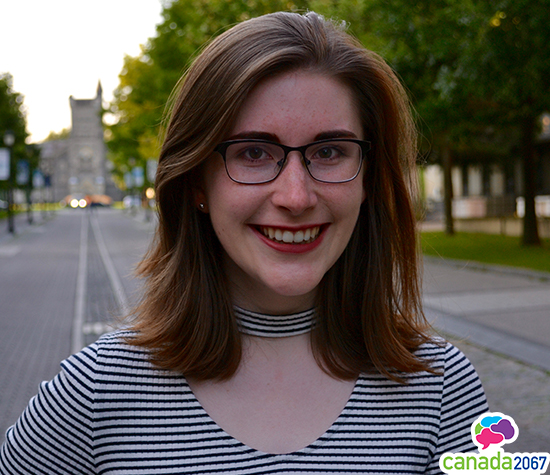Samantha Stuart
Quality Engineering Intern
Synaptive Medical
Learn About My Career
Samantha Stuart is a Quality Engineering Intern at Synaptive Medical.
I was born/grew up in:Collingwood Ontario, Canada
I now live in:Toronto Ontario, Canada
I completed my training/education at:University of Toronto, BASc in Materials Science & Engineering
In my career thus far I've worked in three very different roles:
- Materials Research Assistant
- Intellectual Property Associate
- Quality Engineering Intern
Through each role I've used different STEM related skills and solved different problems. I'll speak to each briefly.
1. Materials Research Assistant - this job was very hands-on and super fun.
The day-to-day involved running experiments in a university lab. The goal was to figure out what caused sinusoidal cracks (cracks shaped like perfect waves) to form in a common type of silicon dioxide (glass) compound when it was spread thinly. I was often chatting with other students in the lab group to get help. And through my program I got to go on tours of cool biomedical research facilities in Toronto, and meet other researchers. I was even able to attend a $400 conference for free thanks to my boss!
2. Intellectual Property Associate - this job involved a lot of writing, and using my STEM knowledge!
Many people think of law as a traditional arts field. However there are lots of opportunities for law and STEM to intersect, such as in writing patents! In this job I met with inventors so they could explain what made their invention novel, useful, and inventive so I could write a convincing patent. Technical communication, quick learning and the ability to convey complex ideas simply were useful here!
3. Quality Engineering Intern - saving lives through planning!
Synaptive Medical is a biomedical engineering firm that develops and manufactures devices to assist with neurosurgery. To do that, it's very important that the devices you're putting in the hands of surgeons are safe to use! Quality Engineering is responsible for making sure that happens. I'm often writing, coding, or meeting with other teams to hear their problems, and planning how our group can solve them.
Canada Wide Science Fair was definitely a rocket ship that helped me get where I am today. At my high school we were required to do science fair projects each year, and I hated it at first. However going through the exercise of brainstorming research ideas each year allowed me to scale up my projects. In Grade 11 I won over $20,000 in prizes and scholarships at a national competition!
The biggest favour I ever did myself was to seek the answers to big questions in high school, and to be persistent in chasing these questions to the end all while learning and making mistakes on the way. When you’re young costs and expectations are lowest, and the margin for error is highest, so it pays to be an optimist.
I found the transition from high school to engineering very difficult. I hit a lot of failures in rapid succession when I was used to seeing high grades from all angles in the past. What I learned to do was take each failure as a learning opportunity. I also took inspiration from the work of others who have overcome failure in my lowest moments. So far it’s been totally worth it!
I'm passionate about biomedical innovations! This is why I have found it very rewarding to work in such a forward-thinking field as Medical Devices.
It's always amazing to see how creative approaches to solving long-standing industry problems with STEM can yield amazing ideas for new products that may not have existed before. This is truly a "disruptive" field. This means that many of the new ideas have the potential to change the way the industry works. I find it very exciting to work on the edge of the future.
Working in a field as inter-disciplinary as medical devices also means you are constantly learning things outside the scope of what you were taught in school. There’s a lot of research being done in partnerships with academic institutions. This is happening in parallel with the marketing, development, and manufacturing processes that need to occur before selling a medical product. It’s truly a team effort. This is why having a background in STEM can be so valuable to apply core concepts design, fact-based problem solving, and data-based decision making.
Currently in Quality Engineering, I'm able to look at what I do and draw direct ties to saving people's lives. Often at Synaptive we hear stories about patients we were able to save with our products who otherwise would not have been able to receive surgery due to high risk of failure. For me this provides incredible satisfaction and motivation to continue working hard.
Work life balance is definitely key! Outside work I'm active in engineering outreach. However I also love to read, play music, and watch performances; there's all kinds of deals on cheap opera and ballet tickets for youth. I'm also a fan of skiing, travel, and kickboxing.
Be proactive, ask questions, and dream big! I got my start in STEM in high school by reaching out to a psychiatrist for science fair research advice. I thought he would never have the time of day for a 15-year-old ... he ended up being a fantastic mentor for me, and wrote a reference letter that won me a full scholarship to university! If you don't ask you don't get.
What I do at work
In my career thus far I've worked in three very different roles:
- Materials Research Assistant
- Intellectual Property Associate
- Quality Engineering Intern
Through each role I've used different STEM related skills and solved different problems. I'll speak to each briefly.
1. Materials Research Assistant - this job was very hands-on and super fun.
The day-to-day involved running experiments in a university lab. The goal was to figure out what caused sinusoidal cracks (cracks shaped like perfect waves) to form in a common type of silicon dioxide (glass) compound when it was spread thinly. I was often chatting with other students in the lab group to get help. And through my program I got to go on tours of cool biomedical research facilities in Toronto, and meet other researchers. I was even able to attend a $400 conference for free thanks to my boss!
2. Intellectual Property Associate - this job involved a lot of writing, and using my STEM knowledge!
Many people think of law as a traditional arts field. However there are lots of opportunities for law and STEM to intersect, such as in writing patents! In this job I met with inventors so they could explain what made their invention novel, useful, and inventive so I could write a convincing patent. Technical communication, quick learning and the ability to convey complex ideas simply were useful here!
3. Quality Engineering Intern - saving lives through planning!
Synaptive Medical is a biomedical engineering firm that develops and manufactures devices to assist with neurosurgery. To do that, it's very important that the devices you're putting in the hands of surgeons are safe to use! Quality Engineering is responsible for making sure that happens. I'm often writing, coding, or meeting with other teams to hear their problems, and planning how our group can solve them.
My career path is
Canada Wide Science Fair was definitely a rocket ship that helped me get where I am today. At my high school we were required to do science fair projects each year, and I hated it at first. However going through the exercise of brainstorming research ideas each year allowed me to scale up my projects. In Grade 11 I won over $20,000 in prizes and scholarships at a national competition!
The biggest favour I ever did myself was to seek the answers to big questions in high school, and to be persistent in chasing these questions to the end all while learning and making mistakes on the way. When you’re young costs and expectations are lowest, and the margin for error is highest, so it pays to be an optimist.
I found the transition from high school to engineering very difficult. I hit a lot of failures in rapid succession when I was used to seeing high grades from all angles in the past. What I learned to do was take each failure as a learning opportunity. I also took inspiration from the work of others who have overcome failure in my lowest moments. So far it’s been totally worth it!
I am motivated by
I'm passionate about biomedical innovations! This is why I have found it very rewarding to work in such a forward-thinking field as Medical Devices.
It's always amazing to see how creative approaches to solving long-standing industry problems with STEM can yield amazing ideas for new products that may not have existed before. This is truly a "disruptive" field. This means that many of the new ideas have the potential to change the way the industry works. I find it very exciting to work on the edge of the future.
Working in a field as inter-disciplinary as medical devices also means you are constantly learning things outside the scope of what you were taught in school. There’s a lot of research being done in partnerships with academic institutions. This is happening in parallel with the marketing, development, and manufacturing processes that need to occur before selling a medical product. It’s truly a team effort. This is why having a background in STEM can be so valuable to apply core concepts design, fact-based problem solving, and data-based decision making.
How I affect peoples’ lives
Currently in Quality Engineering, I'm able to look at what I do and draw direct ties to saving people's lives. Often at Synaptive we hear stories about patients we were able to save with our products who otherwise would not have been able to receive surgery due to high risk of failure. For me this provides incredible satisfaction and motivation to continue working hard.
Outside of work I
Work life balance is definitely key! Outside work I'm active in engineering outreach. However I also love to read, play music, and watch performances; there's all kinds of deals on cheap opera and ballet tickets for youth. I'm also a fan of skiing, travel, and kickboxing.
My advice to others
Be proactive, ask questions, and dream big! I got my start in STEM in high school by reaching out to a psychiatrist for science fair research advice. I thought he would never have the time of day for a 15-year-old ... he ended up being a fantastic mentor for me, and wrote a reference letter that won me a full scholarship to university! If you don't ask you don't get.
When I was a student I enjoyed:
- Art
- Drama
- Foreign Languages
- Literature and Language Arts
- Math
- Music
- Science
- Technology
When I was a student, I would describe myself as someone who:
- Enjoyed doing things on my own
- Liked helping people
- Was motivated by success
- Wanted to be in charge
- Liked being given free range to explore my ideas
- Engaged in volunteer activities
- Liked reading
- Was really creative
- Felt great satisfaction in getting good grades
- Always knew what I wanted to do
Partners

Canada 2067
Let’s Talk Science recognizes and thanks Samantha Stuart for her contribution to Canada 2067.
Related Topics
Explore More Career Profiles
-
Sarra Filali
Career Profiles
Doctoral Student, Science, Technology and Society
I'm a PhD student, specializing in the relationship between science, technology and society. -
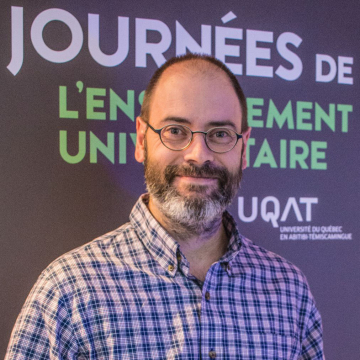
Hugo Asselin (he/him)
Career Profiles
Full Professor
I do research and teach university courses. -
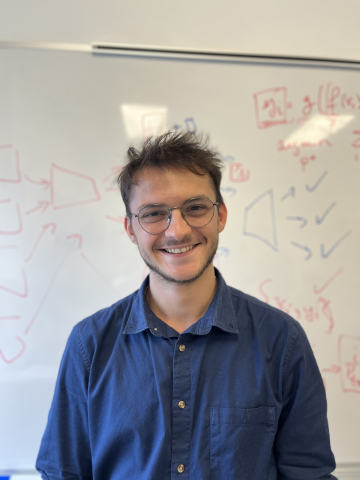
Charles Bricout (he/him)
Career Profiles
Master's Student, Applied Science
I'm a graduate student, and my program includes a major research project supervised by a professor. -
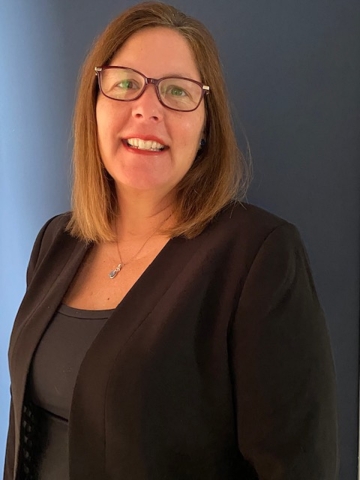
Sonia Francoeur
Career Profiles
Business Manager
I manage sales of laboratory products for part of Quebec and the Ottawa region. -
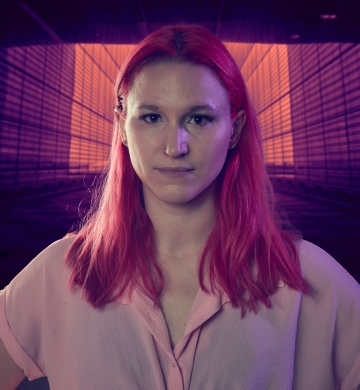
Marion Cossin (she/her)
Career Profiles
Research Engineer
I do research on how acrobats use their equipment and explore the design of new circus equipment and improve the performances. -
Brianna Lummerding
Career Profiles
Agronomic Innovation Manager
I look after all things related to soil management for a group of retailers. -
Li Tan (he/him)
Career Profiles
Molecular Lead
I coordinate the day-to-day operations in the DNA Extraction Lab. -
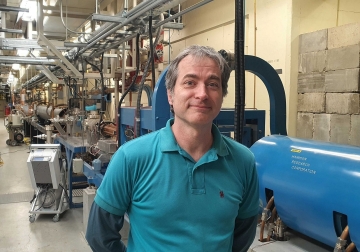
Frédéric Le Pimpec
Career Profiles
Accelerator Operations and Development Manager
I am responsible for the proper functioning, maintenance and updates of the synchrotron accelerator chain at the Canadian Light Source.
-
Tyler Morhart (video)
Career Profiles
Scientist, Beamline Responsible - SyLMAND
I am responsible for the SyLMAND beamline at the Canadian Light Source synchrotron facility. -
Li Tan (Video)
Career Profiles
Molecular Lead
I coordinate the day-to-day operations in the DNA Extraction Lab. -

Rashell Featherstone (she/her)
Career Profiles
Senior Program Associate
I coordinate projects for the development of new products at STEMCELL. -

Kira Hoffman (she/her)
Career Profiles
Postdoctoral Researcher/Fire Ecologist
I am a researcher at both a university and a not-for profit organization where I am gaining experience to become a senior researcher.
